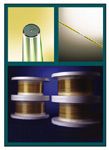Polymicro Technologies
A subsidiary of Molex Incorporated
Company Description
Since 1984, Polymicro Technologies, a subsidiary of Molex Incorporated, has delivered CREATIVE...INNOVATIVE...SOLUTIONS for the aerospace, analytical, astronomy, automotive, bio-defense, biotechnology, communications, energy, manufacturing, medical, military, pharmaceutical, and telecommunication industries. Polymicro is the leader in providing capillary tubing and specialty optical fibers to chromatographers around the world. Our state of the art manufacturing facility and years of knowledge and experience maximize our production capacity, capabilities, and flexibility. We produce hundreds of standard as well as custom products to meet our customers' needs and requirements. By constant improvement of our quality standards and development of new products, Polymicro is positioned to meet the technologies of today and the demands of tomorrow. With fiber and capillary draw towers, a unique glass laboratory, assembly, test equipment, lasers, and laser technology we proudly work with our customers in partnership to provide them with the products they need to grow their business. Polymicro is ISO 9001:2008 certified. Polymicro is a subsidiary of Molex Incorporated's Integrated Products Division.

Chief Chromatographic Techniques Supported
- GC
- CE
- LC, HPLC, and Nano LC
- Lab-on-a-chip
- Spectroscopy, UV to mid-IR
- Cytometry
Markets Served
Polymicro's capillary tubing, optical fibers, fiber optic assemblies, and fiber and tubing arrays are commonly used in the analytical sciences spanning academics and industry. Polymicro products find use in pharmaceutical, environmental and petrochemical analysis, genomics, proteomics, neurology, clinical instrumentation, and a wide variety of related technologies. Typical applications include research, process monitoring and control, quality monitoring and control, forensics, pharmaceutical, petrochemical and environmental analysis, and DNA sequencing, in addition to unique applications requiring precision micro-bore capillary.
Major Products/Services
Polymicro manufactures high-strength, high-temperature flexible fused-silica capillary tubing; light-guiding capillary; flow cells; square capillary tubing; windowed capillary tubes; UV transparent capillary; multimode, step-index fused silica optical fiber with polyimide, silicone, acrylate, and fluoropolymer buffers; solarization-resistant optical fiber for deep UV; broad spectrum fiber; fiber optic cables and assemblies; silica and quartz rods; precision "cleaved to length" tubing pieces; multilumen tubing; and microcomponents such as laser machined fiber tips; telecommunications ferrules and sleeves; and laser-cut and precision cleaved capillary tubing.
Facilities
Polymicro has a 50,000 ft2 facility located in the North Phoenix area. At our location, we have several draw towers that produce a large portion of capillary tubing and multi-mode step-index fibers used throughout the world. Polymicro has its own glass laboratory, assembly department, laser machining department, and sophisticated testing equipment to meet our customers' needs for the highest quality and service. To get your copy of our handbook, simply e-mail our Technical Sales Department at polymicrosales@molex.com. Or you can fax us at (602) 375-4110.

Polymicro Technologies, A subsidiary of Molex Incorporated
18019 North 25th Avenue
Phoenix, AZ 85023
TELEPHONE
(602) 375-4100
FAX
(602) 375-4110
WEB SITE
NUMBER OF EMPLOYEES
115
YEAR FOUNDED
1984

New Method Explored for the Detection of CECs in Crops Irrigated with Contaminated Water
April 30th 2025This new study presents a validated QuEChERS–LC-MS/MS method for detecting eight persistent, mobile, and toxic substances in escarole, tomatoes, and tomato leaves irrigated with contaminated water.

.png&w=3840&q=75)

.png&w=3840&q=75)



.png&w=3840&q=75)



.png&w=3840&q=75)


















